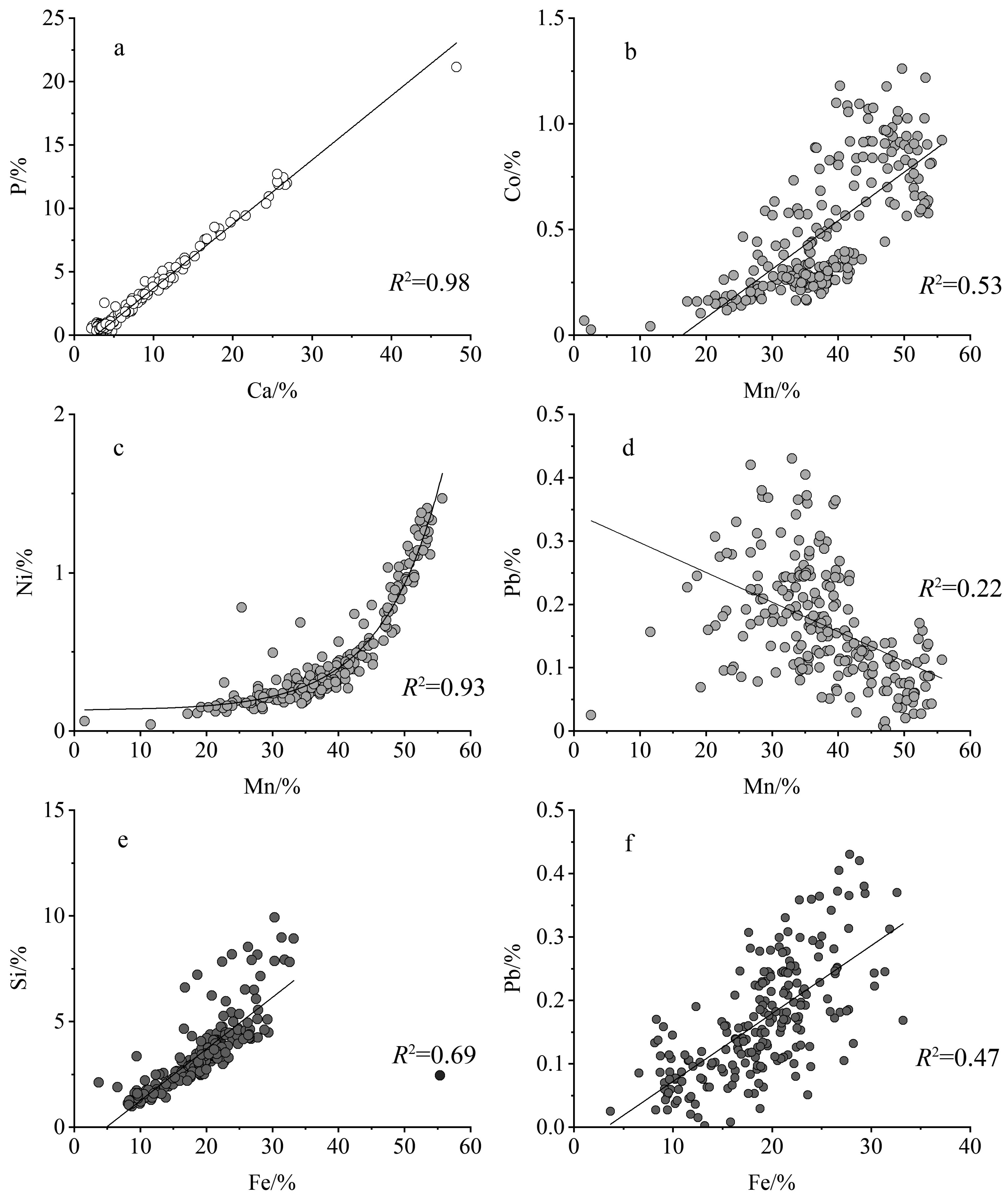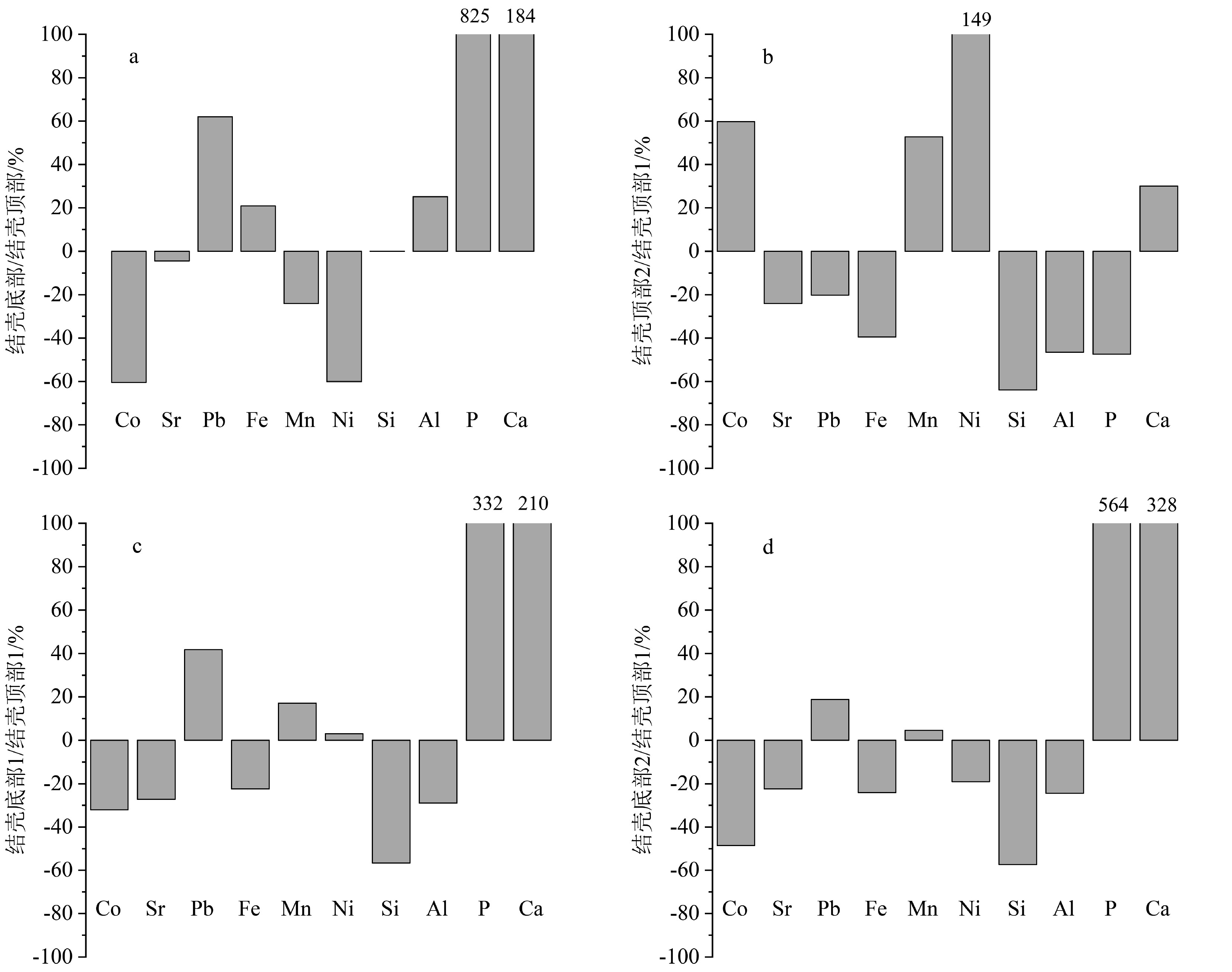Elemental distribution pattern and forming mechanism of the two types of phosphates in ferromanganese crust in Western Pacific Ocean and their implications
-
摘要: 太平洋铁锰结壳在中新世以前大多经历了磷酸盐化,一般认为其形成代表了高生产力时期富磷组分对先期已形成结壳的交代作用,即磷酸盐化事件的产物。然而,前人对铁锰结壳磷酸盐化的机制研究多基于点-线分析元素或同位素,对铁锰结壳生长结构及二维元素分布特征研究较少。本研究以西太平洋水成铁锰结壳MDD53为研究对象,利用电子探针(EPMA)进行高分辨率元素定量分析,并结合微区X射线荧光光谱(μXRF)面扫得到结壳元素二维分布图。电子探针和μXRF结果揭示了该结壳中下部发生了磷酸盐化。μXRF结果显示该结壳存在两种不同类型的磷酸盐富集特征:第一类是结壳顶部中出现零星的Ca、P富集,同时伴随着强烈的后期改造特征,如结壳呈破碎状结构,Fe丢失、Mn相对富集。电子探针数据进一步表明,在成岩改造中,Co、Ni等微量元素发生了相对富集,而Pb则发生了丢失,这一现象反映了这些元素与Fe、Mn不同的亲和力,与大量有机质在结壳海水界面分解导致的成岩扰动特征相符。第二类是结壳底部连续出现的纹层状Ca、P富集特征,且无后期扰动现象,暗示 MDD53结壳底部磷酸盐是同沉积/早成岩作用的产物,而不是反映后期磷酸盐化事件成岩改造的影响。这类未报道过的同沉积磷酸盐可能表明结壳形成早期,其水深相对较浅时,海水中大量磷酸盐与铁锰氧化物胶体共沉淀而产生的磷酸盐富集现象,因而为重建晚白垩世-早新生代高时间分辨率古海洋演化提供了可靠载体。Abstract: Most of the Pacific ferromanganese crusts have experienced phosphatization before Miocene, presumably by impregnation of phosphorus-rich component into the old crust section during the period of high productivity, that is called the product of phosphatization events. Most of the previous studies on phosphatization were based on point/line analysis of element contents or isotopes, while few studies have been devoted to the growth structure and 2-dimentional element distribution. In this study, a hydrogenetic ferromanganese crust (MDD53) sampled from the western Pacific Ocean was analyzed by electron probe X-ray microanalysis (EPMA) and micro–X-ray fluorescence scanning (μXRF), generating high resolution quantitative data on element concentrations and 2-dimensional element maps, respectively. The results of EPMA and μXRF reveal that the middle to lower part of the crust was phosphatized. The μXRF map shows that there are two types of phosphates. The first type shows sporadic enrichment of Ca and P in the top part of the crust, accompanied by strong post-depositional alterations, such as broken structure, Fe loss, and relatively Mn enrichment. The EPMA data further shows that trace element enrichment of Co and Ni as well as depletion of Pb in the phosphatized area. This observation reflects different affinity of these elements with Fe and Mn oxides, which is consistent with the hypothetic phosphatization mechanism of organic matter degradation at the crust-seawater interface and the resulting alteration of the preformed crust. The second type of phosphate is characterized by an unreported structure of continuous Ca and P enriched laminae located at the bottom of the crust. The lack of post-depositional alteration of the growth structure suggests that this type of phosphate is of syn-depositional or early diagenetic in origin, which is distinctly different from post-diagenetic alteration. The syn-depositional phosphate may indicate an early stage coprecipitation of phosphate and ferromanganese oxide colloids in a relatively shallow water depth, making it a reliable paleoceanographic indicator for high temporal resolution studies of the Late Cretaceous-Early Cenozoic period.
-
Keywords:
- ferromanganese crust /
- EPMA /
- μXRF /
- phosphate
-
太平洋水成铁锰结壳形成于富Mn2+、低氧的水体与上涌富氧水体混合的最低含氧带(OMZ)之下,广泛分布于具有强的底流扰动但缺乏碎屑沉积的海底丘陵、海山及高原上[1-3]。水成铁锰结壳(以下简称铁锰结壳)由海水中的水合金属氧化物(主要为铁锰氧化物)胶体缓慢沉淀形成,因此,可以持续吸附周围海水中的溶解金属元素[4-7]。基于铁锰结壳的化学组成不受后期成岩作用影响的假设,结壳的化学信息可以用来反映古海洋演变[8-12]。结壳化学组成及结构特征又与水文、氧化还原条件、生物生产力和水柱成分随时间的变化等因素有关[13-15]。通常而言,太平洋的大多数铁锰结壳根据化学组成的不同可分为两个部分:发生磷酸盐化的老的生长阶段和未发生磷酸盐化的新的生长阶段[12, 16-17]。发生磷酸盐化的铁锰结壳富集Ca和P,同时亏损Fe、Mn和Co 等元素[12, 15-16, 18-19]。铁锰结壳磷酸盐化作用在水深2 500 m以上区域表现较强,而在水深较大时表现较弱[12] 。前人关于结壳磷酸盐化特征研究均基于点-线分析,尚未查明磷酸盐化部分的结壳生长结构、元素二维分布特征及其与磷酸盐化成岩作用的关系。
本文以西太平洋麦哲伦海山链MDD53铁锰结壳为研究对象开展磷酸盐化的机制研究。该结壳前期已开展过Nd-Pb同位素演化研究,并建立了Co年龄模式[9, 20-21]。结壳包含未发生磷酸盐化的顶部(0~60 mm)和发生磷酸盐化的底部(63~119 mm)。本文利用电子探针开展MDD53的主微量含量点分析,并使用微区X射线荧光光谱仪(μXRF)得到元素分布图,这些结果共同揭示了两类不同类型的磷酸盐形成机制,而本文发现的纹层状磷酸盐化特征尚未见报道和描述。
1. 样品和方法
MDD53位于西太平洋麦哲伦海山链(17°26′34″N、150°17′18″E,水深2 700 m,厚度约119 mm),靠近马里亚纳海沟(图1),形成于晚白垩纪,年龄为77 Ma[9, 21]。该结壳为中国大洋协会航次样品, 结壳MDD53 整体呈致密板状, 表面较为光滑。在进行分析前,已利用环氧树脂固化并顺着生长层方向切割成板状(8 cm×4 cm×2 cm),之后进行了抛光、清洗、烘干和喷碳。元素分析在南京大学内生金属矿床成矿机制研究国家重点实验室完成。利用JXA-8800电子探针开展主微量元素Mn、Fe、Si、Al、P、Ca、Co、Pb、Sr的点分析[21]。电子探针电压15 kV,束流2×10−8 A,束斑2 µm,以500 µm间距对样品进行分析测试,测试得到有效结果 219个点,测试总长度117 mm。为了排除黏土或生物碎屑等机械沉积物的影响,在数据处理时删去了Si>10%,Al>4.6%和总元素含量<40%的测点结果;而元素总量小于40%的样品说明Fe、Mn、Si等元素含量均较低,可能代表的是结壳中的微小孔隙。
利用μXRF(美国Atlas IXRF)分析铁锰结壳得到元素二维分布图。仪器配备束斑直径为10 μm和一个150 mm2硅漂移能量色散探测器的铑靶X微束射线光管,加速电压50 kV,电流500 μA,在X-Y方向上电机步进为8 μm,采集频率为80 ms/像素,对样品MDD53进行二维多元素面扫,得到半定量的Al、Si、Fe、Mn、P、Ca、Ti等元素分布图(图2)。
![]() 图 2 MDD53顶部和底部的微区XRF元素含量分布图亮色代表含量相对高而暗色代表含量相对低;下图为Si、P、Ca元素局部区域放大图,图中白色方框对应放大位置。Figure 2. Micro–X-ray fluorescence images of the top to bottom section of MDD53Light colors represent relatively high content and dark colors represent relatively low content. The bottom of figure are enlarged the parts of Si, P, Ca Micro-X-ray fluorescence images, the white box in the figure corresponds to the zoom in position.
图 2 MDD53顶部和底部的微区XRF元素含量分布图亮色代表含量相对高而暗色代表含量相对低;下图为Si、P、Ca元素局部区域放大图,图中白色方框对应放大位置。Figure 2. Micro–X-ray fluorescence images of the top to bottom section of MDD53Light colors represent relatively high content and dark colors represent relatively low content. The bottom of figure are enlarged the parts of Si, P, Ca Micro-X-ray fluorescence images, the white box in the figure corresponds to the zoom in position.2. 结果
2.1 铁锰结壳的结构特征
µXRF元素分布图显示铁锰结壳MDD53在20~50 mm有零星P、Ca富集,但在63 mm以下发生明显磷酸盐化,电子探针数据显示P含量突然升高>1%(图3a)。根据XRF图像将结壳分为顶底部分:结壳顶部(0~63 mm)未发生磷酸盐化或零星磷酸盐化的部分,结壳底部(63~119 mm)发生显著磷酸盐化的部分。结壳按照具体的结构特征和元素分布可以分为4个子部分:结壳顶部1(0~7 mm),结壳顶部2(7~63 mm),结壳底部1(63~93 mm),结壳底部2(9~119 mm)。结壳顶部1呈现较致密的短柱状结构;结壳顶部2结构呈分支柱状结构,中间部分出现破碎孔隙和裂隙,柱状结构的裂隙中充填富Si物质(图2);结壳底部1呈致密的柱状结构,柱状孔隙中充填磷酸盐;结壳底部2呈致密平行且部分呈波浪状的纹层状结构,部分纹层富集Ca、P,而部分纹层则缺少这种富集特征(图2)。
2.2 铁锰结壳的元素分布
电子探针数据表明铁锰结壳顶部与底部元素分布有明显差异:结壳顶部富集Co、Ni、Mn、Sr等元素,结壳底部富集 P、Ca、Pb、Al、Fe、Si等元素(图3)。结壳顶部1元素含量稳定,Fe含量均值为26.5%,Mn含量均值为29.0%(表1),Mn/Fe质量比值为1.1,Si、Al值升高(图3c, j)。与结壳顶部1相比,结壳顶部2的元素含量随深度出现明显变化,Mn含量从 30.5%升高至55.7%再降低至40.2%,与Mn相关的Co、Ni等元素同样先升高再降低。Fe含量从26.5%降低到10.7%再回到22.5%,Si含量从7.8%降低到1.3%再升高至4.4%,Mn/Fe比值由1.2升高至6.2再降至2附近。在整个结壳底部,Mn/Fe比值稳定在1.6左右(图3f),Co、Ni含量稳定,Al含量存在个别高值。结壳底部1中Fe、Mn、Co、Ni等元素含量稳定,P、Ca分别从结壳顶部2的0.4%、3.89%升高至3.4%和9.27%,P、Ca存在两处异常高值。结壳底部2中P、Ca等元素含量相比结壳底部1分别升高至5.2%和12.8%,Mn含量略微降低,Fe含量稳定为20.1%左右。
表 1 MDD53各部分电子探针元素分布的均值Table 1. The average elemental composition of different parts of MDD53 analyzed by electron probe% 取样位置/mm Co Sr Pb Fe Mn Ni Si Al P Ca 顶部(0~63) 0.69 0.08 0.13 17.2 42.7 0.65 3.37 0.82 0.45 3.79 底部(63~119) 0.27 0.08 0.21 20.8 32.4 0.26 3.37 1.03 4.18 10.8 顶部1( 0~7) 0.45 0.11 0.16 26.5 29.0 0.28 7.83 1.41 0.79 2.99 顶部2 (7~63) 0.71 0.08 0.13 16.0 44.3 0.69 2.83 0.75 0.41 3.89 底部1 (63~93) 0.30 0.08 0.22 20.6 34.0 0.29 3.39 1.00 3.40 9.27 底部2 (93~119) 0.23 0.08 0.19 20.1 30.4 0.22 3.33 1.06 5.22 12.8 3. 讨论
3.1 铁锰结壳的成岩作用与磷酸盐化特征
中太平洋铁锰结壳剖面顶层常见以Mn富集为特征的柱状结构,Fe、Si充填在柱状之间,这是典型的水成铁锰结壳生长结构[4]。MDD53结壳顶部1呈短柱状结构,结构孔隙中充填Fe、Si胶结物。µXRF元素分布图显示Fe、Mn含量高,Mn主要分布在柱状结构里,而Fe和少量的生物Si充填在结构孔隙中(图2)。电子探针的数据显示Mn/Fe在结壳顶部1分布稳定,暗示其未受后期成岩作用改造,因此,这些棱柱代表了结壳的原始结构。结壳顶部2主体为分支柱状结构,但其在20~50 mm处结构疏松,裂缝和孔隙较多,表明结壳顶部2受成岩作用影响较大,经历了显著的后期成岩作用。结壳顶部2孔隙中部分无机Si可能是由生物Si原位溶解再沉淀形成而非来自碎屑[1]。铁锰结壳孔隙中的生物Si发生后期成岩作用引起Fe氢氧化物转变成无定形富硅的Fe氢氧化物相,导致了Mn氧化物胶体沉淀,促进了结壳的生长[1]。这种结壳生长机制可能解释了结壳顶部2中Mn与Fe的相反分布可能受Si含量控制(图3c, d, f)。前人推测,有机质的降解可能会产生局部还原微环境,促进铁从周围的生物碳酸盐中再活化迁移[14]。铁锰结壳中生物Si发生后期成岩作用导致包裹的有机质降解,产生的有机配体络合Fe带走部分的Fe,生物Si与剩余Fe重新胶结充填在孔隙和裂缝周围。原来的Fe氧化物受后期成岩作用影响丢失,与铁氧化物相关的Al、Si、Pb等元素含量减少,导致Mn氧化物占比增高。µXRF元素分布图显示孔隙周边出现P、Ca的异常高值,可能是Fe氧化物吸附的P富集形成磷灰石。前人也观察到未发生磷酸盐化的结壳中稳定的P含量可能与结壳中形成肉眼不可见的磷灰石有关[23]。未发生磷酸盐化的结壳中Ca与Mn有一定的相关性,P与Fe和Si有一定的相关性,表明Ca、P分别与Mn氧化物和Fe氢氧化物结合[1, 24]。一般认为铁锰结壳的Mn/Fe比值小于2.5为水成成因,大于2.5为成岩成因[25]。MDD53的Mn/Fe比值随着结构出现孔隙而变化,从1.1升高至6.5再降至1.6,说明该铁锰结壳局部经历了后期成岩改造。而结壳顶部1中Mn/Fe比值相对稳定在1.1左右,表明其未经历后期成岩改造(图3f)。结壳顶部2的底部(50~63 mm)为致密柱状结构,无后期成岩改造的痕迹,元素含量稳定接近结壳顶部1的元素均值(图3)。
大洋铁锰结壳主要的锰氧化物矿物分别为布塞尔矿、水羟锰矿和钡镁锰矿[24, 26-27]。MDD53为水成铁锰结壳,其主要矿物为水羟锰矿和非晶质的铁氧化物针铁矿以及存在的两类磷酸盐。本文的μXRF数据说明两类磷酸盐本身Ca-P组成的类磷灰石是磷灰石相,由P-Ca等组成且无明确结构,由于极其微小难以取样精确分析矿物相。根据μXRF微区XRF图观察(图2),在结壳顶部2中有后期成岩产物磷灰石相伴随着很可能是无定形的Si充填在溶解微裂隙中,而结壳下部的纹层状磷酸盐则无此现象。
结壳底部整体经历了磷酸盐化,根据其具体的结构和元素分布分为两个子部分:结壳底部1和结壳底部2。前人认为铁锰结壳发生磷酸盐化有两种作用机制:一是碳氟磷灰石(CFA)与结壳中碳酸盐的交代形成,二是海水中直接沉淀形成CFA[12]。MDD53结壳底部1的结构整体为致密的短柱状,即铁锰氧化物,P、Ca充填在柱状的孔隙中(图2)。铁锰结壳形成时在早期成岩过程中CFA胶结在结壳结构孔隙中,P、Ca含量在CFA充填的裂隙处出现异常高值(图3)。结壳底部2呈致密的纹层状结构,Fe、Mn、P、Ca等元素在XRF图上也呈层状分布(图2),结壳的原生层理似乎未受磷酸盐化的影响:Mn/Fe比值为1.5左右,表明结壳底部2形成的磷酸盐可能反映了同沉积而非后期成岩改造作用。结壳底部1中磷酸盐在锰氧化物结构间隙紧密分布,而结壳底部2锰氧化物与磷酸盐互层分布(图2)。铁锰结壳的电子探针数据也表明磷酸盐不一定均为后期改造形成,考虑到自始新世以来的板块构造运动(数百公里)和海底沉降(数百米),这可能反映了较老的铁锰结壳形成于水深较浅的环境[12]。前人认为中始新世至晚渐新世发生磷酸盐化的铁锰结壳的致密的块状或层状结构可能是在相对静滞的、分层的海水条件下形成[1, 28-29]。结壳底部2未经历后期成岩作用,CFA与铁锰氧化物互层沉积,而结壳底部1在结构上与结壳顶部1一致为柱状结构,但结构裂隙中充填有早期成岩形成的CFA。因此,结壳形成磷酸盐时并非都经历了后期的成岩改造,也可能由同沉积作用或早期成岩作用形成。
3.2 铁锰结壳不同结构的元素分布特征
一般来说,海水中锰氧化物和铁(氢)氧化物胶体聚集形成铁锰结壳的过程中会吸附大量的溶解元素(Ni、Co、Zn、Pb、Ti等)。元素的富集通常归因于游离和弱络合阳离子Co、Zn和Ni通常与表面带负电荷的锰氧化物相结合,而中性和弱络合阴离子Pb、Ti通常与表面带弱正电荷的铁氧化物相结合[11, 22, 30-31]。本研究的μXRF元素分布图可以观察到这些元素之间共沉淀的关联(图2)。MDD53的EPMA元素分析结果表明,Mn与Co、Ni以及Fe与Pb具有很好的相关性(图4b, c, f)。Ca和P在结壳底部富集主要以CFA的形式存在[16, 18],因此,Ca、P具有良好的相关性(图4a)。CFA呈细脉状充填在结壳底部的裂缝和空隙中,它的形成对结壳的生长产生一定的抑制作用[12]。Ti和Fe的元素分布一致(图2),在成岩作用过程中,Ti可能与Fe(氢)氧化物具有较强的化学亲合力[6, 32]。无定形铁氧化物形成过程中会吸附Pb,因此Fe与Pb有很好的相关性(图4f)。淋滤实验表明,Pb在磷酸盐化结壳中铁氧化物组分向更稳定的CFA相迁移[24]。因此,Pb与Mn呈负相关(图4d)。
结壳顶部1中Fe、Mn、Si、Ni、Pb、Al、Sr等元素含量随结壳剖面深度增大而升高。μXRF元素分布图表明,在结壳最顶部的几毫米可以记录初始沉积特征的元素分布,但结壳顶部往下在后期成岩作用中可能存在元素的局部迁移。结壳顶部2在30~50 mm经历了明显的后期成岩改造导致Fe丢失,Pb也发生同步的丢失(图3d, j)。Mn/Fe比值由1.2升高至6.2再降至2附近,反映了结壳该部分经历了后期成岩改造。铁锰结壳中的Co主要来源于海水,Co2+被(氢)氧化物氧化为Co3+然后被锰氧化物吸附沉淀[33-35]。前人发现Ni比Co对锰氧化物亲和力更强[2, 24, 36]。铁锰结壳中Mn与Co常见呈正相关关系[34](图4b),然而在结壳顶部2中,Mn以及相关元素Ni在40 mm处出现最大值,Co在30 mm出现最大值,这表明Mn与Co变化不同步(图3e, g),可能是在后期成岩过程中部分Mn氧化物水羟锰矿溶解导致部分吸附的Co随着流体沿着裂隙向上部迁移富集。生物Si与Fe氧化物在裂隙中形成富Si的 Fe(氢)氧化物,因此,Fe与Si有很好相关性(图4e)。但在后期成岩过程中形成溶解孔隙,部分Fe、Si丢失(图3c, d)。前人淋滤实验发现了P吸附在铁氧化物相上[24],后期成岩过程中Fe氧化物溶解导致吸附的P的溶解再沉淀,出现局部的磷酸盐富集(图2)。为了分析成岩作用对结壳元素的富集或亏损的影响,本文将结壳顶部1作为原始未受成岩改造的结壳,将其他结壳部分的元素均值与结壳顶部1的元素均值进行均一化(图5)。结果表明结壳顶部2相对富集Mn、Ni、Ca和Co,但后期成岩作用导致Fe氧化物溶解丢失且相对富集Mn及吸附的Co、Ni等元素(图5b)。相对结壳顶部1,结壳底部1和结壳底部2富集P、Ca、Mn和Pb,亏损Co、Sr、Fe、Al和Si等元素(图5c,d)。
![]() 图 5 MDD53磷酸盐化部分与未磷酸盐化部分之间的元素平均值相对差异a. 结壳底部元素均一化结果,b. 结壳顶部2元素均一化结果,c. 结壳底部1元素均一化结果,d. 结壳底部2元素均一化结果。Figure 5. Relative differences in average elemental composition of phosphatized parts to the non-phosphatized parts of MDD53a. The normalized result of the bottom of the crust, b. the normalized result of top part 2, c. the normalized result of bottom part 1, d. the normalized result of bottom part 2.
图 5 MDD53磷酸盐化部分与未磷酸盐化部分之间的元素平均值相对差异a. 结壳底部元素均一化结果,b. 结壳顶部2元素均一化结果,c. 结壳底部1元素均一化结果,d. 结壳底部2元素均一化结果。Figure 5. Relative differences in average elemental composition of phosphatized parts to the non-phosphatized parts of MDD53a. The normalized result of the bottom of the crust, b. the normalized result of top part 2, c. the normalized result of bottom part 1, d. the normalized result of bottom part 2.3.3 两类磷酸盐特征对铁锰结壳作为古海洋变化载体的启示意义
前人认为铁锰结壳发生磷酸盐化与全球气候演化有关[23, 37]。在白垩纪坎帕阶,全球火山活动减少导致大气CO2水平下降,全球温室气候结束[38-39]。这种气候和海洋条件的变化可能导致了太平洋海山周围洋流上涌的加强[11]。深水上升流的加强将底层富营养物质带到海水表层,导致表层生物初级生产力提高,产生的有机颗粒降解消耗更多的氧气引起OMZ扩张,OMZ中低氧、富磷酸盐的水体被带到形成铁锰结壳的海山斜坡,促进了铁锰结壳碳氟磷灰石(CFA)的形成[12, 40-44]。晚新生代,气候由温暖湿润逐渐转向寒冷干燥,大陆风化减弱引起河流不稳定的P输入、海洋P的供应减少,这为结壳磷酸盐化的消失提供了一个可能的解释[23]。前人通过分析多个太平洋的铁锰结壳认为在不同水深铁锰结壳磷酸盐化结束时间不同:浅水结壳(991~1 575 m)的结束时间晚,约为10 Ma,而深水结壳(2 262 m)的结束时间较早,推测为17.1±2.5 Ma[17]。总结起来,磷酸盐化是结壳-海水界面高磷酸盐含量的结果,通常与表层海洋高生产力相关。由于中北太平洋并非所有的结壳都出现了一致的磷酸盐化[10],局域地形和洋流对有机质沉降的影响可能也起到了重要作用。然而MDD53中上部发现的结壳破碎状和强烈后期改造特征以及仅出现零星磷酸盐化特征表明,在大量有机质降解的影响下,结壳可能发生溶解而不是普遍的磷酸盐化作用,并产生了较强的元素迁移。MDD53结壳中下部未受到后期显著扰动的纹层状磷酸盐特征,表明这类磷酸盐化并非“事件”产物,而是伴随结壳生长的一种持续化学特征,海水化学演化信息可以以高时间分辨被保存[45],因而为理解晚白垩至早新生代的海洋环境演化提供了良好载体。未来工作将针对MDD53底部的纹层进一步开展地球化学研究,以理解这些纹层形成的潜在气候驱动机制。
4. 结论
(1)MDD53在晚白垩纪以来形成持续的磷酸盐,并形成了纹层状沉积,代表了同沉积或早期成岩过程的产物,这类磷酸盐伴随着结壳底部 P、Ca元素的富集及Mn、Ni、Co等元素的亏损。μXRF结果还表明结壳顶部2发生明显的后期成岩改造,结壳出现了溶解孔洞和裂隙,导致Mn、Ni、Co的富集及Fe、Si的亏损,在溶解孔隙中仅出现零星的磷酸盐富集。
(2)本文的研究表明纹层磷酸盐并非结壳受到后期交代的产物,而无磷酸盐化也并不代表结壳同沉积的元素特征未受过后期扰动,需要结合结壳形貌和二维元素分布特征进行仔细甄别。
(3)本文利用μXRF揭示的结壳磷酸盐化与成岩作用特征为准确利用铁锰结壳反演晚白垩纪以来深海化学演化提供了新的约束。
致谢:感谢中国大洋样品馆提供研究所需样品。
-
图 2 MDD53顶部和底部的微区XRF元素含量分布图
亮色代表含量相对高而暗色代表含量相对低;下图为Si、P、Ca元素局部区域放大图,图中白色方框对应放大位置。
Figure 2. Micro–X-ray fluorescence images of the top to bottom section of MDD53
Light colors represent relatively high content and dark colors represent relatively low content. The bottom of figure are enlarged the parts of Si, P, Ca Micro-X-ray fluorescence images, the white box in the figure corresponds to the zoom in position.
图 5 MDD53磷酸盐化部分与未磷酸盐化部分之间的元素平均值相对差异
a. 结壳底部元素均一化结果,b. 结壳顶部2元素均一化结果,c. 结壳底部1元素均一化结果,d. 结壳底部2元素均一化结果。
Figure 5. Relative differences in average elemental composition of phosphatized parts to the non-phosphatized parts of MDD53
a. The normalized result of the bottom of the crust, b. the normalized result of top part 2, c. the normalized result of bottom part 1, d. the normalized result of bottom part 2.
表 1 MDD53各部分电子探针元素分布的均值
Table 1 The average elemental composition of different parts of MDD53 analyzed by electron probe
% 取样位置/mm Co Sr Pb Fe Mn Ni Si Al P Ca 顶部(0~63) 0.69 0.08 0.13 17.2 42.7 0.65 3.37 0.82 0.45 3.79 底部(63~119) 0.27 0.08 0.21 20.8 32.4 0.26 3.37 1.03 4.18 10.8 顶部1( 0~7) 0.45 0.11 0.16 26.5 29.0 0.28 7.83 1.41 0.79 2.99 顶部2 (7~63) 0.71 0.08 0.13 16.0 44.3 0.69 2.83 0.75 0.41 3.89 底部1 (63~93) 0.30 0.08 0.22 20.6 34.0 0.29 3.39 1.00 3.40 9.27 底部2 (93~119) 0.23 0.08 0.19 20.1 30.4 0.22 3.33 1.06 5.22 12.8 -
[1] Jeong K S, Jung H S, Kang J K, et al. Formation of ferromanganese crusts on northwest intertropical Pacific seamounts: electron photomicrography and microprobe chemistry [J]. Marine Geology, 2000, 162(2-4): 541-559. doi: 10.1016/S0025-3227(99)00091-2
[2] De Carlo E H, Fraley C M. Chemistry and mineralogy of ferromanganese deposits from the equatorial pacific ocean[M]// Keating B H, Bolton B R. Geology and Offshore Mineral Resources of the Central Pacific Basin. Springer, New York, NY. 1992: 225-245.
[3] Hein J R, Schwab W C, Davis A. Cobalt-and platinum-rich ferromanganese crusts and associated substrate rocks from the Marshall Islands [J]. Marine Geology, 1988, 78(3-4): 255-283. doi: 10.1016/0025-3227(88)90113-2
[4] Sutherland K M, Wankel S D, Hein J R, et al. Spectroscopic insights into ferromanganese crust formation and diagenesis [J]. Geochemistry, Geophysics, Geosystems, 2020, 21(11): e2020GC009074.
[5] Hein J R, Koschinsky A, Bau M, et al. Cobalt-rich ferromanganese crusts in the Pacific[M]//Cronan S D. Handbook of Marine Mineral Deposits. Florida: CRC Press, 2000: 239-279.
[6] Koschinsky A, Hein J R. Uptake of elements from seawater by ferromanganese crusts: solid-phase associations and seawater speciation [J]. Marine Geology, 2003, 198(3-4): 331-351. doi: 10.1016/S0025-3227(03)00122-1
[7] Wang X L, Planavsky N J, Reinhard C T, et al. A Cenozoic seawater redox record derived from 238U/235U in ferromanganese crusts [J]. American Journal of Science, 2016, 316(1): 64-83. doi: 10.2475/01.2016.02
[8] Ling H F, Burton K W, O'nions R K, et al. Evolution of Nd and Pb isotopes in Central Pacific seawater from ferromanganese crusts [J]. Earth and Planetary Science Letters, 1997, 146(1-2): 1-12. doi: 10.1016/S0012-821X(96)00224-5
[9] Chen T Y, Ling H F, Hu R, et al. Lead isotope provinciality of central North Pacific Deep Water over the Cenozoic [J]. Geochemistry, Geophysics, Geosystems, 2013, 14(5): 1523-1537. doi: 10.1002/ggge.20114
[10] Li\ng H F, Jiang S Y, Frank M, et al. Differing controls over the Cenozoic Pb and Nd isotope evolution of deepwater in the central North Pacific Ocean [J]. Earth and Planetary Science Letters, 2005, 232(3-4): 345-361. doi: 10.1016/j.jpgl.2004.12.009
[11] Jiang X D, Zhao X, Zhao X Y, et al. A magnetic approach to unravelling the paleoenvironmental significance of nanometer-sized Fe hydroxide in NW Pacific ferromanganese deposits [J]. Earth and Planetary Science Letters, 2021, 565: 116945. doi: 10.1016/j.jpgl.2021.116945
[12] Koschinsky A, Stascheit A, Bau M, et al. Effects of phosphatization on the geochemical and mineralogical composition of marine ferromanganese crusts [J]. Geochimica et Cosmochimica Acta, 1997, 61(19): 4079-4094. doi: 10.1016/S0016-7037(97)00231-7
[13] Hein J R, Bohrson W A, Schulz M S, et al. Variations in the fine-scale composition of a Central Pacific ferromanganese crust: paleoceanographic implications [J]. Paleoceanography, 1992, 7(1): 63-77. doi: 10.1029/91PA02936
[14] Josso P, Rushton J, Lusty P, et al. Late Cretaceous and Cenozoic paleoceanography from North-east Atlantic ferromanganese crust microstratigraphy [J]. Marine Geology, 2020, 422: 106122. doi: 10.1016/j.margeo.2020.106122
[15] Koschinsky A, Hein J R. Marine ferromanganese encrustations: archives of changing oceans [J]. Elements, 2017, 13(3): 177-182. doi: 10.2113/gselements.13.3.177
[16] Ji L H, Liu G S, Huang Y P, et al. The distribution of iodine and effects of phosphatization on it in the ferromanganese crusts from the Mid-Pacific Ocean [J]. Acta Oceanologica Sinica, 2015, 34(8): 13-19. doi: 10.1007/s13131-015-0704-x
[17] Nishi K, Usui A, Nakasato Y, et al. Formation age of the dual structure and environmental change recorded in hydrogenetic ferromanganese crusts from Northwest and Central Pacific seamounts [J]. Ore Geology Reviews, 2017, 87: 62-70. doi: 10.1016/j.oregeorev.2016.09.004
[18] 王吉中. 磷酸盐化对中太平洋海山富钴结壳物质组分的影响[D]. 北京: 中国地质大学(北京), 2005. WANG Jizhong. Effects of pho-sphatization on composition of Co-rich crusts on central pacific seamounts[D]. Beijing: China University of Geosciences (Beijing), 2005
[19] 崔迎春, 石学法, 刘季花. 富钴结核粒径分形特征[J]. 海洋湖沼通报, 2008(3):67-70 doi: 10.3969/j.issn.1003-6482.2008.03.009 CUI Yingchun, SHI Xuefa, LIU Jihua. Fractal characters of grain size of cobalt-rich nodule [J]. Transactions of Oceanology and Limnology, 2008(3): 67-70. doi: 10.3969/j.issn.1003-6482.2008.03.009
[20] 胡镕, 陈天宇, 凌洪飞. 晚新生代北太平洋西部深水洋流演化: 来自铁锰结壳Nd同位素的证据[J]. 科学通报, 2012, 57(31):4077-1086 doi: 10.1007/s11434-012-5322-9 HU Rong, CHEN Tianyu, LING Hongfei. Late Cenozoic history of deep water circulation in the western North Pacific: Evidence from Nd isotopes of ferromanganese crusts [J]. Chinese Science Bulletin, 2012, 57(31): 4077-1086. doi: 10.1007/s11434-012-5322-9
[21] 周枫, 凌洪飞, 陆尊礼, 等. 中太平洋铁锰结壳铅同位素研究[J]. 海洋地质与第四纪地质, 2005, 25(1):55-62 ZHOU Feng, LING Hongfei, LU Zunli, et al. Research of lead isotope of ferromanganese crusts from central Pacific Ocean [J]. Marine Geology & Quaternary Geology, 2005, 25(1): 55-62.
[22] Kawabe M, Fujio S. Pacific ocean circulation based on observation [J]. Journal of Oceanography, 2010, 66(3): 389-403. doi: 10.1007/s10872-010-0034-8
[23] Hyeong K, Kim J, Yoo C M, et al. Cenozoic history of phosphogenesis recorded in the ferromanganese crusts of central and western Pacific seamounts: implications for deepwater circulation and phosphorus budgets [J]. Palaeogeography, Palaeoclimatology, Palaeoecology, 2013, 392: 293-301. doi: 10.1016/j.palaeo.2013.09.012
[24] Koschinsky A, Halbach P. Sequential leaching of marine ferromanganese precipitates: genetic implications [J]. Geochimica et Cosmochimica Acta, 1995, 59(24): 5113-5132. doi: 10.1016/0016-7037(95)00358-4
[25] Halbach P, Segl M, Puteanus D, et al. Co-fluxes and growth rates in ferromanganese deposits from central Pacific seamount areas [J]. Nature, 304(, 5928, ): 716-719.
[26] 赵建如, 初凤友, 杨克红, 等. 中太平洋C海山富钴结壳铁锰矿物的组成、成分特征及其成因意义[J]. 海洋学研究, 2009, 27(1):15-21 doi: 10.3969/j.issn.1001-909X.2009.01.003 ZHAO Jianru, CHU Fengyou, YANG Kehong, et al. Manganese mineral components, compositional characteristics and their implication for genesis of cobalt-rich crust from C seamount in Central Pacific [J]. Journal of Marine Sciences, 2009, 27(1): 15-21. doi: 10.3969/j.issn.1001-909X.2009.01.003
[27] Frank M, O’nions R K, Hein J R, et al. 60 Myr records of major elements and Pb-Nd isotopes from hydrogenous ferromanganese crusts: Reconstruction of seawater paleochemistry [J]. Geochimica et Cosmochimica Acta, 1999, 63(11-12): 1689-1708. doi: 10.1016/S0016-7037(99)00079-4
[28] Friedrich G, Schmitz-Wiechowski A. Mineralogy and chemistry of a ferromanganese crust from a deep-sea hill, central Pacific, "Valdivia" cruise VA 132 [J]. Marine Geology, 1980, 37(1-2): 71-90. doi: 10.1016/0025-3227(80)90012-2
[29] Segl M, Mangini A, Beer J, et al. Growth rate variations of manganese nodules and crusts induced by paleoceanographic events [J]. Paleoceanography, 1989, 4(5): 511-530. doi: 10.1029/PA004i005p00511
[30] Manceau A, Gorshkov A I, Drits V A. Structural chemistry of Mn, Fe, Co, and Ni in manganese hydrous oxides: Part I. Information from XANES spectroscopy [J]. American Mineralogist, 1992, 77(11-12): 1133-1143.
[31] Manceau A, Gorshkov A I, Drits V A. Structural chemistry of Mn, Fe, Co, and Ni in manganese hydrous oxides: Part II. Information from EXAFS spectroscopy and electron and X-ray diffraction [J]. American Mineralogist, 1992, 77(11-12): 1144-1157.
[32] Liu R L, Wang M Y, Li W Q, et al. Dissolved thorium isotope evidence for export productivity in the subtropical North Pacific during the late Quaternary [J]. Geophysical Research Letters, 2020, 47(11): e2019GL085995.
[33] 胡镕, 陈天宇, 凌洪飞. 晚第四纪中北太平洋铁锰结壳Fe/Mn变化: 对古气候变化的响应[J]. 高校地质学报, 2012, 18(4):751-758 doi: 10.3969/j.issn.1006-7493.2012.04.016 HU Rong, CHEN Tianyu, LING Hongfei. Fe/Mn variations of late Quaternary ferromanganese crusts from the central North Pacific: implications for the paleoenvironment change [J]. Geological Journal of China Universities, 2012, 18(4): 751-758. doi: 10.3969/j.issn.1006-7493.2012.04.016
[34] 姜学钧. 海洋铁锰氧化物沉积物中常、微量元素的地球化学特征[D]. 青岛: 中国海洋大学, 2007. JIANG Xuejun. Geochemistry of major and minor elements in marine ferromanganese oxide deposits[D]. Qingdao: Ocean University of China, 2007
[35] 武光海, 周怀阳, 张海生, 等. 海山铁锰结壳中反映环境氧化程度的新指标[J]. 中国科学 D辑:地球科学, 2007, 50(3):371-384 doi: 10.1007/s11430-007-2011-7 WU Guanghai, ZHOU Huaiyang, ZHANG Haisheng, et al. New index of ferromanganese crusts reflecting oceanic environmental oxidation [J]. Science in China Series D:Earth Sciences, 2007, 50(3): 371-384. doi: 10.1007/s11430-007-2011-7
[36] Wen X, De Carlo E H, Li Y H. Interelement relationships in ferromanganese crusts from the Central Pacific Ocean: Their implications for crust genesis [J]. Marine Geology, 1997, 136(3-4): 277-297. doi: 10.1016/S0025-3227(96)00064-3
[37] Hein J R, Yeh H W, Gunn S H, et al. Two major Cenozoic episodes of phosphogenesis recorded in equatorial Pacific Seamount deposits [J]. Paleoceanography, 1993, 8(2): 293-311. doi: 10.1029/93PA00320
[38] Thibault N, Harlou R, Schovsbo N H, et al. Late Cretaceous (late Campanian-Maastrichtian) sea-surface temperature record of the Boreal Chalk Sea [J]. Climate of the Past, 2016, 12(2): 429-438. doi: 10.5194/cp-12-429-2016
[39] Batenburg S J, Voigt S, Friedrich O, et al. Major intensification of Atlantic overturning circulation at the onset of Paleogene greenhouse warmth [J]. Nature Communications, 2018, 9(1): 4954. doi: 10.1038/s41467-018-07457-7
[40] Miller K G, Wright J D, Fairbanks R G. Unlocking the ice house: Oligocene-Miocene oxygen isotopes, eustasy, and margin erosion [J]. Journal of Geophysical Research:Solid Earth, 1991, 96(B4): 6829-6848. doi: 10.1029/90JB02015
[41] Salamy K A, Zachos J C. Latest eocene-early oligocene climate change and Southern Ocean fertility: inferences from sediment accumulation and stable isotope data [J]. Palaeogeography, Palaeoclimatology, Palaeoecology, 1999, 145(1-3): 61-77. doi: 10.1016/S0031-0182(98)00093-5
[42] Halbach P, Puteanus D. The influence of the carbonate dissolution rate on the growth and composition of Co-rich ferromanganese crusts from Central Pacific Seamount areas [J]. Earth and Planetary Science Letters, 1984, 68(1): 73-87. doi: 10.1016/0012-821X(84)90141-9
[43] Halbach P E, Sattler C D, Teichmann F, et al. Cobalt-rich and platinum-bearing manganese crust deposits on seamounts: nature, formation, and metal potential [J]. Marine Mining, 1989, 8(1): 23-39.
[44] Lear C H, Elderfield H, Wilson P A. Cenozoic deep-sea temperatures and global ice volumes from Mg/Ca in benthic foraminiferal calcite [J]. Science, 2000, 287(5451): 269-272. doi: 10.1126/science.287.5451.269
[45] Josso P, Van Peer T, Horstwood M S A, et al. Geochemical evidence of Milankovitch cycles in Atlantic Ocean ferromanganese crusts [J]. Earth and Planetary Science Letters, 2021, 553: 116651. doi: 10.1016/j.jpgl.2020.116651
-
期刊类型引用(1)
1. 王世奇,叶现韬,张传林,石学法. 中太平洋海山群玄武岩磷酸盐化特征及其对全岩地球化学的影响. 海洋地质与第四纪地质. 2024(01): 67-80 .  本站查看
本站查看
其他类型引用(0)




 下载:
下载:






